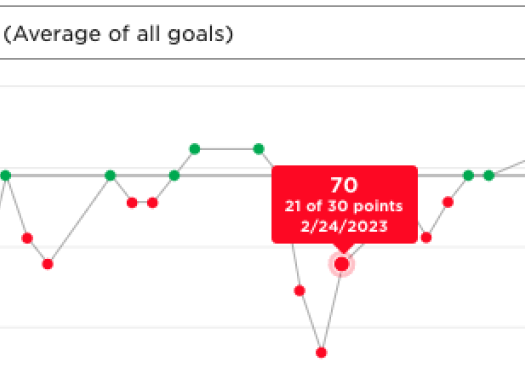Digital Transformation: Student Intervention Tracking (Team)
Problem
How might we encourage digital student intervention tracking for more insights?
Approach
My designer created a digital tracking and analysis experience for the most common behavior intervention in schools today: Check-in/Check-out (CICO).
Result
More CICO interventions are up-to-date than other interventions. The feature has also become a pillar of MTSS corporate marketing.
Check-in/Check-out (CICO)
CICO is the most common behavior intervention in schools.
Each day, a student is given a set of behavior goals and each goal can earn a total number of possible points.
Throughout the day, educators at each class period assign the students points based on how well they met each goal.
At the end of the day, the student compares their actual scores with possible points, and reflects on them with an educator.
Client
Panorama Education
Duration
3 months (Dec 2022-Feb 2023)
My Role
Product Design Team Lead
Team
1 Designer, 2 Product Managers, 1 Engineering Lead, 2 Engineers
Design Approach
I provided design support, UX writing, and problem-solving support to the lead designer and product manager as they executed on the product vision.
This project was also one of the first with a quarter-long, agile release roadmap where additive functionality shipped monthly.
Release 1: Custom progress monitoring now included CICO requirements.
This required updating creation flows, update flows and analysis screens.
Release 1.5: Progress monitoring additional functionality
This included daily tracking templates (PDF and Excel), automation with score calculations, and score customization.
Release 2: Multi-goal tracking
This added layers of functionality to the creation flows, update flows and analysis screens.
Challenges
How do we coordinate with other squads that are already overwhelmed?
CICO lives in the intervention plan system, owned by a different product area and scrum teams.
My designer reviewed designs (synchronously and asynchronously) with those other teams multiple times a week to:
Integrate their released features into their in-progress work;
Tap into their expertise with specific questions;
Coordinate release dates; and
Check consistency in design system and component usage.
How do we integrate necessary new features, while avoiding burdensome changes?
Because CICO was a unique intervention, it needed adjustments to existing workflows and data visualizations.
The designer, engineers and product, regularly weighed the effort and system implications. For example:
CICO users may need to change goals, but editing was not available for other interventions. Allowing editing would have major impacts to intervention graphing, so the team opted for in-product education, while adding it to future roadmaps.
Calculating CICO scores manually is error-prone. Even though math calculations in product added complexity, it added delightful functionality and a component that could be used in other areas of the product. The release of this function was delayed from 1.0 to 1.5 release.
How much behavior change can we expect of users?
The designer developed a vision for digitizing the entire process from intervention setup to teacher tracking to data analysis.
I encouraged the designer to run concept tests with their vision before planning the releases.
Thanks to this research, they learned how much behavior change would be required by teachers.
They opted to postpone those features until they saw adoption for the other functionality.
Results
At launch, we saw a significant percentage of users organically discovering the feature and using it before product marketing announcements. The feature has also become an important marketing pillar for MTSS supports — it’s even the subject of our most popular blog posts.
Additionally, More CICO intervention plans are up-to-date than the average intervention plan.

